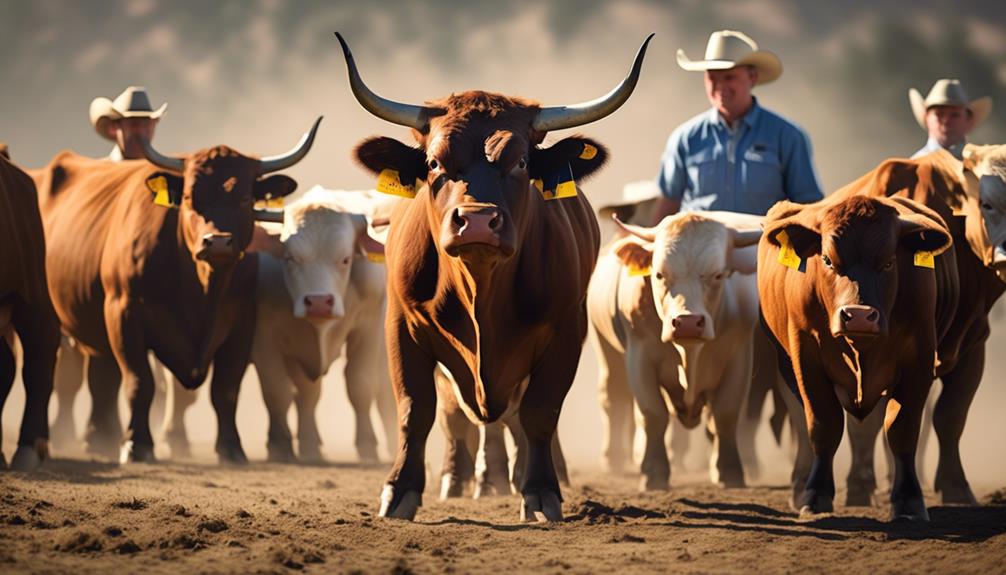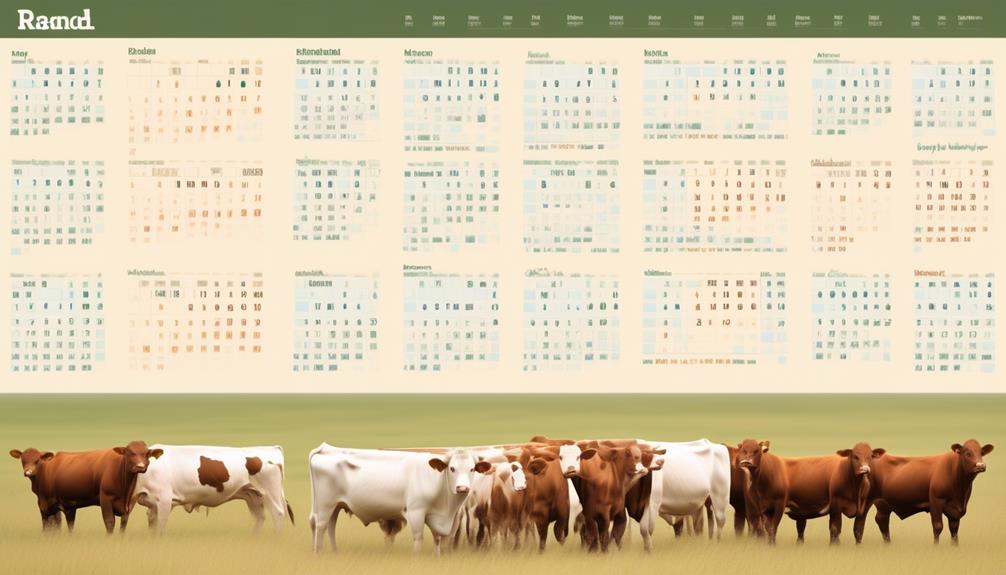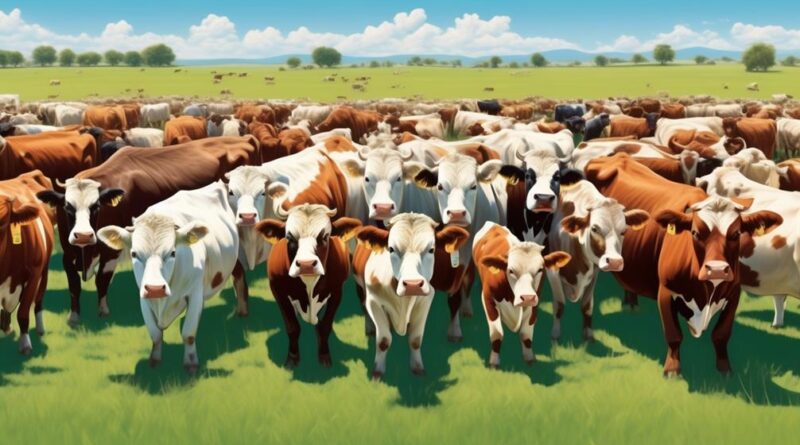3 Best Breeding Strategies for Cattle Herds
Have you ever wondered what the most effective breeding strategies are for improving your cattle herd's genetics?
With so much information out there, it can be challenging to determine which strategies will yield the best results for your specific operation. However, by exploring the top three breeding strategies for cattle herds, you can gain valuable insights into the methods that have proven to be most successful in enhancing the quality and productivity of your herd.
Whether you're a seasoned breeder or just starting out, understanding these strategies could make a significant difference in the long-term success of your operation.
Selecting Superior Sires

When selecting superior sires for your cattle herd, prioritize genetic traits that align with your breeding goals and herd management practices. Sire evaluation is crucial in ensuring the genetic diversity and overall health of your herd. It's essential to assess potential sires based on their genetic makeup, performance, and hereditary traits. Look for bulls that have a proven track record of producing offspring with the desired characteristics. Consider their genetic diversity and how it complements the existing gene pool in your herd.
Genetic diversity plays a significant role in the long-term success of your cattle operation. When evaluating sires, aim to introduce new genetic traits that can enhance the overall vigor and adaptability of your herd. Seek out sires with diverse genetic backgrounds to minimize the risk of inherited diseases and improve the overall resilience of your cattle. By incorporating genetic diversity into your breeding program, you can mitigate potential health issues and increase the overall productivity of your herd.
When it comes to sire evaluation, consider using advanced genetic testing and performance data to make informed decisions. Look for sires that have a history of producing calves with high growth rates, superior meat quality, and disease resistance. Utilizing modern technology and data-driven approaches can help you identify superior sires that align with your breeding objectives and contribute to the genetic diversity of your herd.
Implementing Genetic Testing
Consider implementing genetic testing to gain valuable insights into the hereditary traits and genetic makeup of potential sires for your cattle herd. DNA analysis through genetic testing can provide crucial information that can guide your breeding decisions and contribute to herd optimization.
Here are three key benefits of implementing genetic testing:
- Accurate Identification of Genetic Defects: Genetic testing allows you to identify potential genetic defects in potential sires, enabling you to make informed decisions about which animals to include in your breeding program. By screening for specific genetic markers associated with undesirable traits, you can avoid passing on these defects to future generations and maintain the overall health and quality of your herd.
- Enhanced Breeding Selection: Genetic testing empowers you to make more informed decisions when selecting sires for breeding. By analyzing the DNA of potential sires, you can identify individuals with desirable traits, such as improved growth rates, disease resistance, and superior meat quality. This information allows you to strategically breed for specific traits, ultimately enhancing the overall productivity and profitability of your cattle herd.
- Improved Herd Management: Genetic testing provides valuable insights that can contribute to herd optimization. By understanding the genetic makeup of your cattle, you can make more strategic breeding decisions, streamline your breeding program, and work towards developing a more uniform and high-quality herd.
Incorporating genetic testing into your breeding program can significantly impact the long-term success and sustainability of your cattle herd. By leveraging DNA analysis, you can make more informed breeding decisions, optimize your herd, and work towards achieving your breeding goals.
Utilizing Artificial Insemination

Considering the benefits of genetic testing, you can also explore the advantages of utilizing artificial insemination to enhance the genetic potential of your cattle herd. Artificial insemination (AI) offers several benefits that can significantly impact the genetic progress of your herd.
One of the key advantages is the ability to use semen from superior bulls, which can lead to improved genetics and overall productivity. This method also provides an opportunity to increase the rate of genetic gain within your herd by accessing high-quality genetics that may not be locally available.
When it comes to success rates, artificial insemination offers a more controlled breeding process, which can lead to higher conception rates compared to natural breeding. Additionally, AI allows for the use of semen from genetically superior sires, further increasing the potential for genetic improvement within the herd.
Cost benefits are also an important consideration. While there are initial costs associated with AI, such as purchasing semen and equipment, the long-term benefits can outweigh these expenses. AI can lead to reduced labor and maintenance costs associated with natural breeding methods, as well as minimizing the risks of disease transmission and injury that can occur during natural mating. It also allows for better herd management and record-keeping, which can contribute to overall cost-effectiveness in the long run.
Employing Embryo Transfer Techniques
To optimize the genetic potential of your cattle herd, employing embryo transfer techniques can be a valuable method for rapidly spreading superior genetics within your herd. This advanced reproductive technology offers several benefits for enhancing fertility and increasing productivity in your cattle operation.
Here's why you should consider employing embryo transfer techniques:
- Maximizing Genetic Potential: By using embryo transfer, you can multiply the impact of your most productive and genetically superior cows. This enables you to rapidly increase the number of offspring from your best-performing animals, ultimately enhancing the overall productivity and quality of your herd.
- Accelerating Genetic Progress: Embryo transfer allows you to access elite genetics from top-performing animals without the need for those animals to carry the pregnancy themselves. This significantly accelerates the rate of genetic improvement within your herd, leading to faster gains in desirable traits such as milk production, growth rates, and disease resistance.
- Expanding Market Opportunities: With embryo transfer, you can produce multiple offspring from your best cows and bulls, allowing you to supply superior genetics to other breeders and potentially expand your market reach. This can create additional revenue streams for your operation while also contributing to the genetic improvement of the cattle industry as a whole.
Employing embryo transfer techniques can be a powerful tool for cattle breeders seeking to enhance their herd's genetics, improve productivity, and capitalize on market opportunities.
Managing Breeding Season

Managing breeding season in your cattle herd requires careful planning and strategic implementation to optimize reproductive efficiency and genetic progress.
Breeding season timing plays a crucial role in the success of your breeding program. It's essential to align the breeding season with the natural reproductive patterns of your cattle and consider factors such as environmental conditions and nutritional availability. By synchronizing the breeding season with optimal conditions, you can enhance conception rates and calving intervals, ultimately improving the overall productivity of your herd.
In addition to timing, implementing effective reproductive management techniques is vital for maximizing breeding season outcomes. This involves conducting regular reproductive health assessments for your cattle to identify any potential issues that may hinder successful breeding. Utilizing methods such as ultrasound for pregnancy diagnosis and estrus synchronization can help in managing breeding season more efficiently.
Furthermore, employing sound record-keeping practices enables you to track breeding performance and make informed decisions for future breeding seasons.
Improving Herd Health and Nutrition
Improving the overall health and nutrition of your cattle herd is essential for maximizing productivity and ensuring optimal breeding outcomes. By focusing on feed management and disease prevention, you can significantly enhance the well-being of your herd.
Feed Management
- Balanced Diet: Ensure that your cattle have access to a well-balanced diet that meets their nutritional needs. This includes a mix of high-quality forage, grains, and supplements to support their growth and reproductive health.
- Regular Feeding Schedule: Establish a consistent feeding schedule to provide your cattle with the necessary nutrients at the right times. This can help prevent nutritional deficiencies and promote overall health.
Disease Prevention
- Vaccination Protocols: Work with a veterinarian to develop a comprehensive vaccination program tailored to your herd's specific needs. This proactive approach can help prevent the spread of common diseases and minimize the risk of illness among your cattle.
Implementing effective feed management practices and prioritizing disease prevention measures will contribute to the overall health and well-being of your cattle herd. Not only will this support their productivity and reproductive success, but it will also create a foundation for a thriving breeding program.
Monitoring Reproductive Performance
You can monitor the reproductive performance of your cattle herd by keeping detailed records of breeding activities and using reproductive health indicators.
Tracking fertility rates and optimizing mating schedules are crucial aspects of monitoring reproductive performance. By maintaining accurate records of breeding activities such as mating dates, calving dates, and pregnancy checks, you can effectively track fertility rates within your herd. This data can help you identify any potential issues and make informed decisions to optimize mating schedules for improved reproductive performance.
Reproductive health indicators, such as the percentage of cows successfully bred within a defined breeding season and the calving interval, provide valuable insights into the overall reproductive performance of your herd. By regularly monitoring these indicators, you can identify trends and patterns that can guide your breeding strategies. For example, if you notice a decline in fertility rates or an increase in calving intervals, it may indicate the need for adjustments in breeding management or herd nutrition.
Utilizing tools such as ultrasound technology for early pregnancy diagnosis can also aid in monitoring reproductive performance. Early detection of pregnancies allows for timely intervention in cases of reproductive issues, ultimately contributing to improved overall reproductive efficiency within the herd.
Incorporating Crossbreeding Programs
To further enhance your cattle herd's reproductive performance, incorporating crossbreeding programs can be a strategic approach to maximize the genetic potential of your livestock. Crossbreeding introduces genetic diversity, leading to improved traits in the offspring, such as disease resistance, fertility, and growth rates.
Here are some key points to consider when incorporating crossbreeding programs into your cattle herd management:
- Hybrid Vigor Benefits: Through crossbreeding, you can harness the benefits of hybrid vigor, also known as heterosis. This phenomenon results in offspring with superior qualities compared to their purebred parents, such as increased productivity, vitality, and overall health. However, it's important to note that hybrid vigor may vary across different crosses and traits.
- Limitations of Hybrid Vigor: While hybrid vigor offers substantial benefits, it's essential to acknowledge that these advantages may diminish over generations. Continuous crossbreeding without proper selection and management could lead to loss of hybrid vigor, emphasizing the need for a well-planned breeding program.
- Crossbreeding Impact on Market Value: Incorporating crossbreeding programs can positively impact the market value of your cattle. Crossbred animals often exhibit desirable traits that appeal to both commercial producers and buyers, potentially increasing the value of your livestock. However, market demands and preferences may influence the extent of this impact, so it's important to stay informed about market trends.
Frequently Asked Questions
Can Cattle Herds Be Successfully Bred Using Natural Mating Methods, or Is Artificial Insemination Always Necessary?
You can successfully breed cattle herds using natural mating methods, which promote reproductive efficiency and genetic diversity. However, artificial insemination may be necessary to achieve specific breeding goals or address reproductive challenges.
What Are the Potential Risks and Benefits of Using Embryo Transfer Techniques in Cattle Breeding?
When considering embryo transfer in cattle breeding, it's crucial to weigh the potential risks and benefits. Ethical considerations, genetic diversity, and fertility management play key roles in evaluating the use of reproductive technologies in breeding programs.
How Can Environmental Factors, Such as Climate and Pasture Quality, Impact the Success of Breeding Strategies for Cattle Herds?
Climate and pasture quality significantly impact breeding success. Environmental factors influence reproductive outcomes and herd health. Understanding how these elements affect breeding strategies is crucial for maximizing the success of cattle herds.
Are There Specific Health and Nutrition Considerations That Are Particularly Important for Successful Cattle Breeding?
To ensure successful cattle breeding, it's crucial to manage health and nutrition. Meeting nutritional requirements and implementing effective health management practices are essential. Genetic selection and promoting reproductive efficiency are also key factors for successful breeding.
What Are the Potential Challenges and Benefits of Incorporating Crossbreeding Programs Into a Cattle Herd's Breeding Strategy?
Incorporating crossbreeding programs into your cattle herd's breeding strategy brings both challenges and advantages. It can enhance genetic diversity and lead to hybrid vigor, but it also requires careful planning and management to maximize benefits.
Conclusion
So, when it comes to breeding your cattle herds, remember to focus on selecting superior sires, implementing genetic testing, and utilizing artificial insemination.
By managing breeding seasons, improving herd health and nutrition, and monitoring reproductive performance, you can ensure the success of your breeding program.
And don't forget to consider incorporating crossbreeding programs to maximize the genetic potential of your cattle herds.
With these strategies in place, you can set your cattle herds up for long-term success and profitability.
